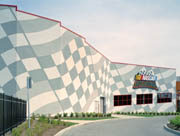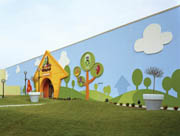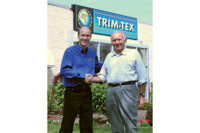
When reliable and energy-efficient foam is combined with powerfully accurate computers, the technology has taken the use of EPS foam to a new level for construction projects. A project's CAD drawings can now flawlessly reproduce an architect's vision by entering them into a computerized foam-cutting machine.
Each of the five-member design team at the architecture firm of Kiku Obata and Co. shared a vision to create forms reflecting the horticulture and haute couture attractions at the World's Fair, including rose and fashion motifs at two of the mall entrances.
"The EIF system has a lot of flexibility," says Kevin Flynn, vice president of Kiku Obata. "Anything you can imagine you can create."
Project Manager James "J.C." Elston, with Mills Corp., explains there are a variety of visual effects at each of the six entrances to the Mills Mall St. Louis.
"At every entrance, there is a new theme," Elston says. "It's a great concept."
The EIFS was the Senerflex Classic PB Wall System manufactured by Senergy, LLC of Jacksonville, Florida.

Fair foam
The St. Louis Mills Mall is located in the city's northwest section of Hazelwood off State Highway 370, about a 20-minute drive from the famous St. Louis Arch. The $250-million mall has been open for nearly a year, is 1.1 million square feet and contains retail and entertainment destinations, including 11 anchor stores, more than 175 retailers, and a variety of theme restaurants and entertainment venues.Among the entertainment available is the Regal St. Louis Mills Stadium 18 movie theater. There is also a food court and full service sit-down restaurants, a NASCAR Speed Park, and ESPN X Games Skatepark. The "ice ZONE" skating rink is the official practice facility of the St. Louis Blues professional ice hockey team.
To keep the ice rink cool and the mall climate comfortable year-round, Grau Contracting applied exterior panels to the mall. The company prefabricated about 900 panels at its St. Charles headquarters. Computers were again instrumental to the building team, as most of the fabricating work on the panels was completed with automated welders and screw guns.
According to Johnnie Crow, project manager for Grau Contracting, they installed the panels for the base building and most of the anchor stores, except one building. Grau applied a single-story panel throughout, except for the theater, which called for two-story panels.
Grau panels cover about 8,000 liner feet of a total of approximately 10,000 linear feet around the mall. The average panel was 13 feet wide by 25 feet tall, and they used 10-inch metal studs with 5/8-inch sheathing. Grau's subcontractor, JDR Construction, then applied 3 inches of EPS foam in the field. The panels fabricated in St. Charles were trucked to the job site in loads of about 20 panels.
Meanwhile, Falcon Foam EPS was being delivered to the mall and work proceeded on the forms and icons at each entrance, which were themed to reflect the shops or attractions inside. A rocket ship, trees and a giant doghouse were placed on a landscape of green rolling hills and a blue sky with puffy white clouds as an introduction to a children's entrance of the mall.
Falcon Foam manufactured the EPS for the façades on all the entrances, recalled Corey Hemman, product development specialist for the EPS manufacturer, which is located in Perrysville, Mo. Before Falcon Foam delivered the EPS to the contractors, its engineers and production team worked with the architects to determine the exact dimensions of each piece.
"We came up with a way to take their drawings and incorporate the design into the EPS that we supplied to them," Hemman says.
The contractors hired to install the EPS had considered projecting the shapes onto the wall at night and then cutting the foam with hot knives or by drawing the shapes onto the foam before cutting. However, Falcon Foam was able to remove all the guesswork from the task.
"We basically took it from something that was very open to interpretation and labor intensive, and made it into what was drawn on the blueprints," Hemman says.
Each 2-foot-by-4-foot block of EPS foam was cut at Falcon Foam's Perrysville plant.
According to Product Specialist Rick Moore, with Negwer Materials of St. Louis, Falcon Foam's expertise in producing EPS packaging helped them with the intricate cuts they achieved to create the EIFS shapes.
"None of the other EPS manufacturers around here indicated they could even do it," notes Moore. "The decorative cuts were already made in the foam when it arrived on the site."
Negwer provided the Senerflex Classic PB Wall System for the project, including the Senergy adhesive that bonded the Falcon Foam product to the panels fabricated by Grau.
The wall system had to have a higher R-value than is typical for shopping malls, so Falcon Foam increased the density of its EPS to 1.25 pounds and raised the thickness of each block to 3 inches.
According to Falcon Foam's Darren Skaggs, field fabrication can lead to a lot of interpretation and a computerized system can reveal potential errors in a CAD drawing in the process.
"It also brought some of the accountability onto the architect," Skaggs says. "They had to bring up their level of play."

The pieces fit
Once the pieces of foam are cut during manufacturing, they are numbered and labeled so the pieces arrive similar to a jig saw puzzle that comes with a chart resembling a paint-by-numbers set."We can produce it so it can be assembled efficiently on the job site," says Hemman, noting that some of the complicated shapes were mechanically fastened when necessary.
Many of the exterior walls received two or more layers of EPS to create a raised 3-D finish to the walls, eliminating the need to paint any shadow effects onto the exterior. While the entrance shapes were as tall as 30 feet high, some of the walls contained shapes as long as 300 feet.
"The whole exterior was intricate shapes and designs," Hemman says.
Once the virgin EPS pieces were assembled at the mall entrances, a fiberglass mesh was applied to the forms and then an EIFS basecoat was applied before an EIFS finish coat completed the shape of the figure. More than 70 custom integral colors were chosen to complete the figures. The EIFS took five months to apply.
While the figures were themed to reflect the past World Fair in St. Louis, the exterior walls of any building can be transformed.
"Instead of having a sign on the side of your building, the exterior of your building can be your sign or product," Hemman says. "People don't even think of doing this."
Niehaus Construction Services installed the 22,000-square-foot outside wall of the ice ZONE skating rink that features the name of the rink with a St. Louis Blues logo below it. Both forms were placed on an EIFS background of overlapping hockey stick and curved color bands. The giant sized wall features, such as the ones adorning the ice ZONE, are floodlit at night and are visible by the observant driver along the interstate more than a quarter-mile away.
"It's the most colorful building you will ever see," says David Giulvezan, who is an estimator and project manager for Niehaus.
And the installation was easier than expected, Giulvezan recalls.
During the peak of installation, more than 100 plasterers climbed scaffolding or were raised on lifts to begin troweling the cementitious bonding agent to the back of the foam and onto the exterior wall panels. The plasterers then hand troweled the EPS foam with EIFS finish in one of the various colors selected for the exterior of the mall.
At the border between colors of stucco, each piece of foam had been precisely cut into a wedge to allow for a smoother transition between color changes.
The plasterers often had to start at the top of the EIFS wall and move to another top section to avoid bleeding of the colors. They covered nearly 500,000 square-feet of EIFS.
The size and magnitude of the St. Louis Mills Mall project required three contractors to install the various buildings that comprised the mall. JDR Construction completed about 137,500 square feet of the wall, including the base building and the figures at each entrance.
Phillips Interior/Exterior Systems Inc. installed the remaining 127,000 square feet of wall, which was responsible for the EIFS on the anchor stores.
Most of the eight mall entrances introduce a theme that is continued into one of six indoor "neighborhoods" where the stores are also grouped by themes. The Mills Corp., headquartered in Arlington, Va., has developed more than 30 U.S. malls that combine retail, discount, outlet shopping, and entertainment for a concept they call "shopertainment." There are 218 stores and restaurants inside the St. Louis Mills Mall and outside there is a pond for bumper boats and a racetrack for midget stock cars.
While the mall cannot compare to the grandeur seen in the Grecian architecture of the palaces at the World's Fair, the mall had one similarity, it has integrated some of the most advanced technology available.


Report Abusive Comment